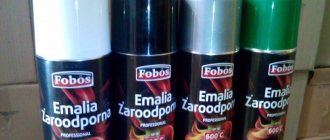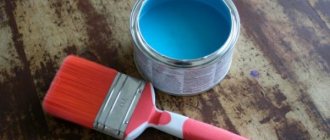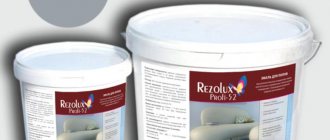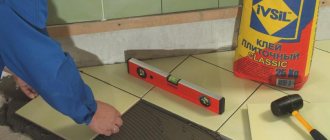Sooner or later, every apartment owner encounters the aging of the bathtub, the appearance of rusty spots, chips or scratches on it. However, not everyone will decide to replace an outdated bathtub. After all, this will cause a lot of trouble not only in terms of repairs, but also financially require large expenses. But even a non-specialist can restore a bathtub using aerosol enamel in a can. And it costs an order of magnitude less money. How to use it, read our article and watch the video. Additionally, read some reviews.
How to choose the right bath paint?
To decide what to paint the bathtub with, you need to assess the extent of its damage. If there are deep chips or cracks, then first you need to carry out preparatory work so that after priming the surface becomes smooth, and then apply thick paint. If there are no significant flaws, and the bath has simply lost its shine, this means that it was not cared for correctly, the surface was damaged by acids and alkalis. In this case, you can restore the bathtub using spray paint.
Advantages and disadvantages of bath enamel in cans
The paint in cans dries quickly, adheres well to the enamel coating, and is easy to apply. Shake the can before application; the paint does not need to be mixed with hardeners.
Advantages of spray paint:
- application is quick and easy, no additional tools are required;
- enamel dries very quickly;
- the material fits well, the surface becomes smooth;
- spray paint has different colors and shades;
- These products can be used to cover bathtubs made of steel and cast iron.
This type of material also has its disadvantages:
- different colors are not mixed to obtain the desired shade;
- If the application is incorrect, smudges or sagging may appear.
Basic rules for applying bath enamel in cans
Before starting the main work, the bathtub must be cleaned, then sanded, and degreased with a solvent. The can of enamel must be shaken well and rough sprayed so that the stream flows evenly. During painting, the can of enamel must be held strictly vertically; spraying is carried out at a distance of 30 centimeters in a thin layer. There should be no bubbles or smudges on the surface, otherwise the enamel in these places will peel off after drying. To ensure a high-quality surface, the enamel must be applied in a thin layer several times. If the enamel is partially used, then the container is turned with the valve down, and then sprayed until the stream becomes discolored. Thus, the can can be used several times. Since the aerosol can for painting a bathtub has a certain pressure, you should not leave it in a place where there will be direct exposure to the sun. Do not store the cylinder at temperatures above 50 degrees, and do not use it near an open fire. After use, the cans should not be burned or pierced; if the enamel is epoxy, then application is carried out in a well-ventilated area.
Surface preparation
To properly paint a bathtub with any type of enamel using pouring, spraying or classic brush/roller technology, you need to perform a number of steps to prepare the surface:
- grinding - with medium-grain sandpaper P-40 - P-60, the enamel layer is roughened for better adhesion to the repair compound;
Treatment of existing coating with abrasive material. - rust removal – areas with traces of corrosion must be cleaned down to the metal base; areas where the existing paint begins to peel/crack are treated in the same way;
- dust removal - abrasive, dust, dirt from previous work is removed with a vacuum cleaner;
- heating – pour hot water into a bowl for 10 minutes;
- dismantling - there is no need to remove the bathtub, you should unscrew the handles, headrests, drainage and overflow systems, faucets embedded in the side, shower head holders, and additionally treat these areas with sandpaper;
Dismantling of overflow and drain systems. - drying - a technical or regular hairdryer removes the remaining moisture on the inner surface;
Processing the bowl with hot air. - degreasing - in the instructions for enamels, each manufacturer must indicate which solvents can be used to degrease the surface.
Degreasing of sanitary ware from the inside.
The industry produces special preparations that convert rust into harmless chemical compounds. They can be used in the second stage instead of sanding.
Rust converter.
At the last stage, the junction of the bathroom walls with the side of the bowl is covered with masking tape.
Taping the bathtub around the perimeter with masking tape.
Place a container under the drain hole in case of paint leakage. It is enough to seal the remaining holes with several layers of tape on the reverse side so that the coating lies in the necks completely over the entire depth.
If there are deep scratches or chips of the factory enamel, these areas must be puttied. Otherwise, the depressions will be visible under the newly applied coating.
Bath putty.
For this purpose, automotive quick-hardening putties or special repair compounds for plumbing products are used.
Bathtub restoration technology using enamel in cans
- First, you need to remove all rust stains from the bathtub; for this you can use oxalic acid diluted with water. The mixture should be made in the form of a slurry, and the bath should be treated with it using a cloth swab or sponge. Apply the mixture not only to rusty areas, but also to the remaining smooth enamel, then you need to wait up to 40 minutes and wash everything thoroughly with water. If the stains are very stubborn and the acid does not help, then it is necessary to clean them using sandpaper or a drill with a special attachment. Work should be performed in protective clothing, gloves, goggles and a respirator. After the bath is washed off, it needs to be dried.
- After the surface has dried, apply a primer in liquid or aerosol form. If you use a primer in a can, you need to shake it well first. After applying the primer, the bath is left to dry.
- At the last stage, the enamel is applied in several thin layers, at a distance of up to 30 centimeters from the surface, while the container must be held strictly vertically. The bath is then left to dry.
If the bathtub has significant damage, then first remove the old enamel using a drill with a special attachment or sandpaper. During work, you need to protect your respiratory system from dust; for this, wear a respirator. Then the surface must be degreased, rubbed with ordinary soda, then washed off with hot water and dried. At the last stage, they begin to prepare the enamel and paint it, apply the product so that no streaks form, the surface should be smooth. The bathtub can be cleaned in another way, without the use of oxalic acid; for this, cleaning powder is poured onto the surface. And then, using sandpaper, thoroughly clean the bathtub from the previous coating. When the entire surface is evenly cleaned, pour hot water into the bath and leave for up to 20 minutes. Then the water is drained, the surface is thoroughly dried, degreased, and the primer begins.
Painting
Painting an old bathtub is the easiest way out if there is a need for a simple restoration.
It has many advantages:
- Simplicity and price. You only need special paint and a brush (a roller will not work around the round transitions.
- The bathroom does not need to be dismantled. And in the case of cast iron, this is important.
- It's easy to choose any color.
However, there are also a lot of disadvantages:
- Bath paint has a very strong smell, so you have to put up with the scent. And if there is no fan, it will spread throughout the apartment.
- The chipped enamel will not go away, but will simply be covered with a new layer.
- Even good paint will last no more than 2 years.
You can buy any paint with the note “For baths”. You will also need a simple set of tools:
- Alkaline-based cleaner or regular “Whiteness”.
- A horsehair brush with a width of 90 millimeters, or preferably 2.
- Solvent No. 646 or construction acetone. Important! Other organic solvents cannot be used.
- Any lint-free cloth.
Preparation
Before you paint a cast iron or iron bathtub, you need to prepare it. This can be done with an alkali solution (White, Mole, Mr.Muscle for cleaning pipes). Afterwards, the composition is washed off and removed with any detergent, for example, for cars.
However, if the painting is major, you can skip this step. To do this, you will need a grinder or a drill with a brush (popularly “quartz brush”). It removes all the enamel from the surface down to the metal.
You can paint the bathroom at this stage, after cleaning, but it is better to first treat the surface with a primer.
Painting
How to paint a bathtub? As was said, paint and varnish compositions marked “for the bath” are suitable. But at home it is better to paint the bathtub with acrylic-based enamel.
Before painting, you need to prepare the brush - remove all the crumbling bristles. Then carefully cover the sides of the bowl.
Here it is worth knowing that the paint dries “touch” in about a day. It finally polymerizes only after 7 days.
Do-it-yourself bathtub restoration
First you need to do the preparatory work; for this you need sandpaper, detergent, and solvent. The surface of the bathtub must be washed with a detergent, then everything is thoroughly dried; for this you can use a hairdryer. Then the surface is thoroughly polished; it must be smooth so that no flaws appear after enamel coating. To do this, use fine-grained sandpaper, then deep scratches will not form on the surface. After this, remove all remaining dust from the bathroom, and then degrease it with a solvent or baking soda. In order not to paint nearby objects and the wall, use masking tape and cellophane. After all nearby objects are covered with film, you can begin the main work. The enamel is applied at temperatures up to 25 degrees, and it applies evenly. It is necessary to spray the enamel evenly to avoid peeling in the future, at a distance of up to 30 centimeters. The enamel is applied in thin layers several times, making sure that there are no bubbles or sagging. At this point the work is considered complete, the bath is left until completely dry.
Preparatory measures
To paint a bathtub, you must first complete a number of preparatory steps. First of all, clean the inner surface of the bathtub itself from limescale and grease. To do this, you need to use an alkaline agent, the usual Pemolux or Sanox will do. But you cannot use substances that contain chlorine. Degreasing is simple: apply the substance to the surface with a dampened sponge and rinse off after 20 minutes.
Next, the surface needs to be cleaned of dirt, rust, and old paint, if any. Here you will need a grinding machine or electric drill. You need to protect your face with a respirator, wear safety glasses and gloves. A lot of dust and debris will be in the air from the sanding machine. But using an electric tool it is easy to remove the old layer. And in the drainage areas and in the inner corners you need to work with a wire brush or medium-grain sandpaper.
After this, the surface will be matte and rough, without corrosion and signs of old contamination. If there are significant mechanical defects (chips, cracks, dents), then they need to be puttied, otherwise in the future they will grow into large cracks. And then all that remains is to replace the bathtub with a new washing tank.
At this point the surface preparation can be considered complete. All that remains is to vacuum it, rinse it again with an acid solution to repeat the degreasing procedure. There should be no dust left in the air from previous work. No matter what paint is chosen, the surface preparation always remains the same:
- washing and degreasing;
- processing with electric tools;
- repeated degreasing and washing.
Then you will get the desired level of paint adhesion, due to which the service life of the new enamel layer will increase significantly. It is advisable to clear the room of nickel equipment and remove all earthenware items from there for a while. During the painting process, the enamel will release various volatile substances that will negatively affect nickel products. The washing machine is usually covered with plastic film to also protect its surface from enamel deposits.
Characteristics and method of using bath enamel in cans
Bathroom enamel in epoxy-based spray cans is waterproof and adheres well to ceramic and enamel coatings. This enamel in cans is highly durable and has high adhesion for ceramics and enamel bases. The enamel contains resins, thanks to which the coating becomes durable, the color and shine are preserved, and the surface is resistant to detergents. Enamel in cans is used to restore the coating of bathtubs, sinks, washbasins, shower stalls, bidets, and other appliances made of ceramics or earthenware.
Bath enamel has the following properties:
- a durable coating is formed;
- high temperature resistance;
- beautiful color and shine;
- high resistance to detergents.
How to properly use bath enamel in cans:
- The surface that will be painted must first be cleaned, sanded with sandpaper, all gloss must be removed, and then degreased. When using paint in spray cans, the surface does not need to be primed.
- The can must be shaken for three minutes so that the color is uniform and the spray element does not clog. Also, when painting, the can must be constantly shaken.
- Before starting the main work, a test spray is carried out to make sure that the paint comes out of the can evenly.
- The can must be held in the hand in a strictly vertical position; spraying is carried out at a distance of up to 30 centimeters from the surface to be painted. Apply the paint in several thin layers, waiting for up to 5 minutes, then the coating will be of high quality. The paint should be applied evenly over the entire coating; there should be no smudges, sagging or bubbles, as this will later lead to peeling of the material.
- If the paint in the can has not been completely used, the valve must be thoroughly cleaned. The container is turned over with the sprayer down, pressed on it, and wait until the stream is discolored. If this is not done, the enamel will dry out in the valve element and will be unsuitable for further use.
- The paint dries quickly, so the surface can be used after just 48 hours. The can of bath enamel should be stored at room temperature, away from open flames and heating devices.
- If the damage to the surface of the bathtub is not significant, then the most suitable option for restoration is enamel in cans; in order to correct serious flaws, chips or deep scratches, thick paint should be used.
To choose the right enamel for bathtub restoration, you first need to assess the extent of its damage, then clean the surface, sand it thoroughly; if you use an angle grinder with an emery attachment, the work will go faster. If the damage is significant, then the surface is degreased and primed. When using enamel in epoxy-based cylinders, no primer is used. After this, enamel is sprayed evenly over the entire surface in several thin layers. You can do this work yourself, without the help of specialists; also, restoring a bathtub allows you to save money; there is no need to purchase a new device. With proper preparation of the base and uniform spraying, the result is a smooth and shiny surface. All work must be carried out in protective clothing, goggles and a respirator so that dust during cleaning and paint during spraying do not get on the skin and mucous membranes.
Receiving the information.
Consider where you got information about bathtub restoration services. The “master” himself found you by ringing the doorbell and offering a service, or maybe you saw an ad on a lamppost (the wall of a house, an entrance door), know that information should not be forced. You must come to the choice of whether to enamel your bathtub or not yourself. And this choice must be conscious. 1. Advertisement on a lamppost. — this type of advertising is most often used by private owners; large companies do not want to spoil city property and building facades. But sometimes “the house he sends him to hangs up his craftsmen with advertisements. Be that as it may, whether to order from such a person or not is up to you. However, it is worth understanding that in case of marriage, the arrival of such a master will depend only on his desire. It wouldn't hurt to make sure the person is local. If either a bath restoration master (or any master) is local or at least lives in your area, then it is easier to hold such a person accountable (if necessary). 2. Advertisements in newspapers - Newspapers are probably the second most popular means of advertising (after advertisements on poles).
m you can find both scammers and serious companies. If there is just a phone number, then think about whether you need to contact it, but if there is an Internet site, then go to it and be curious. 3. Internet sites. — The Internet in Russia is a space for relatively free communication. Not sure if this will last long. It is on the Internet that you can study any issue carefully and in detail. Be it enameling bathtubs or anything else. It is on the Internet that you can check a company for reviews, both positive and negative. Moreover, as a rule, it is a large number of positive reviews that should raise suspicion. Let's explain why: As a rule. Clients and customers are not very willing to leave positive reviews. This is understandable in principle, because good work is not a feat, but a normal state of affairs. Think about the last time you left a good review of someone’s work. A bath should always be done well. And if the site does not yet have a feedback form, then this is not just a reason to think, but also to laugh at the naivety and arrogance of the site builders :). Negative reviews. People leave these reviews with much more enthusiasm. They can often be left with or without reason. Does this relate to the quality of the work on the bath, or the appearance of the master, or maybe his manner of communication. A person can leave negative feedback for almost any reason. trong>More advice on this matter - But also understand that a competing company can also leave a negative review. This is what often happens on the Internet. Although custom “negative” reviews are very easy to identify, they often look downright delusional. There are also a lot of so-called “intermediary” sites on the Internet, or as they are also called by real masters, “enthusiast sites.” This is a type of internet site. Which pretends to be a reputable company, describes its activities in clever words, and tries to convince clients on its pages that all of its specialists are “extremely experienced”, with enormous work experience. And at the same time, it actively hires workers on its other pages. In fact, such sites are essentially just dispatch services. A freelancer sits at his computer, sculpts a website and sends orders to outside “masters” for money. Naturally, such types do not carry any guarantee for their masters. Yes, they actually don’t care about it. By stamping “stays” and promoting them in search engines, they are only interested in new clients. Such sites are not so easy to identify. A constantly hanging job advertisement on the site indicates a high turnover of “masters”; in fact, intermediary sites do not even hire them for work; he completed the order and received a percentage. The same “master” can work for different sites and at the same time time to answer to no one. Ask about the Enamel used to cover the bathtub. Self-leveling acrylic, Enamel for bathtub restoration or Liquid acrylic. You need to pay special attention to what you will cover the bathtub with. I would even say that we need to pay GREAT attention to this. Because most of the “hack-working bathtub restorers” are trying to save money on this. Let’s say it straight away and without doublethink. BATHTUBS CANNOT BE RESTORED WITH ENAMELS IN AEROSOL CANS. No matter how their companies advertise to you... Believe our experience, in half a year this enamel will turn yellow and fall off. These enamels can be used to cover small cracks, chips, in those places of the bathtub where it does not touch the water, or they can be used to paint over rust spots on washing machines or refrigerators, or tiles. This is what they are designed for. But in no case for a complete restoration of the bathtub. Why are we writing about these very aerosol cans? Our craftsmen often visit all sorts of construction stores and often ask, for the sake of checking, “is there any kind of paint that can be used to paint a bathtub?” And for some reason, the first thing that sellers offer is aerosol enamel in a can... But if the seller in the store may simply be ignorant of enamels, then the “master” who says that he restores bathtubs with enamels from aerosol cans is a real hack, kick him in the neck. Epoxy enamels for baths: In our advanced 21st century, the industry produces a huge number of enamels.
alleys are different and for different purposes. Much less for baths. In our opinion, and many masters (real masters) will agree with us that the best enamel for covering bathtubs existing on our market is the enamel called “Reflex 50”. Attention!!! — This is the ONLY bath enamel produced by this company. Old jar New jar From domestic analogues, Bath Enamels, we singled out the St. Petersburg “Epovin”. It is quite possible that other craftsmen offer to cover the bathtub with enamel from another company; it is possible that this enamel is intended “for bathtubs” and perhaps it will be of good quality. In any case, do not be lazy to ask the company for the name of the enamel, and look on the Internet for the website of the manufacturer of this coating. And read for yourself WHAT the enamel they produce is INTENDED FOR. (example with Enamel Reaflex 50) We ourselves tried to call the companies and ask what they could use to coat your bathtub, but there were so many colors that we had to separate them into a separate article. Read the “Detailed article” Ask about the drying time of the enamel. All enamels intended for coating household plumbing are based on epoxy resin, the crystallization process of which at a temperature of 15 to 25°C takes about 120 hours.
For example, Tikkurilaa enamel “Reflex 50” has a drying time of 7 days. Russian "Epovin" - 5 days. And if suddenly a craftsman tells you that “Finnish enamel” dries in 24 hours - 3 days... Believe me, he is deceiving you. It will cover your bathtub and the enamel surface will be dry to the touch on the second day. You can even pour water into it after a couple of days - nothing will happen right away. But in this case, the coating will last no more than six months and will definitely peel off in places where moisture gets in. Once again, be careful!!! If you are offered enameling of a bathtub with a drying period of 1-3 days, think about how you are going to paint the bathtub.
Liquid acrylic, Self-leveling acrylic, Self-leveling bath: Acrylics - (Self-leveling bath, liquid acrylic and self-leveling acrylic) are the fastest drying materials. Baths coated with them can be used after 36 hours.
Price - must be clearly stated on the website Types of work performed by the company, and the prices for them must be clearly stated on the website or in the price list. And in the open. The price on the website must match the prices announced by the dispatcher. Be careful with “companies” that hide prices for their work.
This is an important point concerning not only the work of enameling bathtubs. In general, in everything. You won’t contact an online store where in place of the price (for example, a telephone) there will be the inscription “call, find out the price”... This is an outright scam. The price in this case will depend on who the hacks take you for. The dispatcher over the phone may say one price, but the “master” may say something completely different. And then try to prove something. The price should be HONEST and understandable. If the website says that enameling a bathtub costs (for example) 100 rubles, then this price should be announced by the master. When they start telling you about “hidden” surcharges, they say that you have to pay 10 rubles extra for travel, another 10 rubles for washing the bathtub with acid, and then another 10 rubles for puttingtying chips. Hang up immediately.











